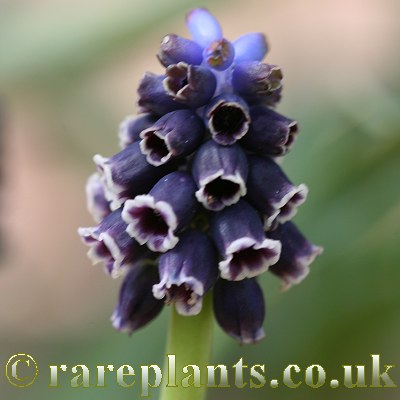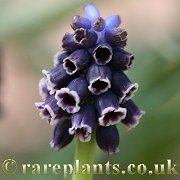Description
A new Turkish species described by Y. Bağcı & S. Doğu in the Nordic Journal of Botany 27: 243-246, 2009. It is clearly a member of what might be called the “discolor group” and is closely related to both Muscari coeleste and M. macbeathianum though it differs from both by possessing bulblets and from the former by having shorter scapes and pedicels and by sometimes having a few sterile flowers present in the flower spike. From macbeathianum it differs by having a smaller bulb and only 2-5 narrowly linear leaves (rather than 8-9 in macbeathianum).
The species is a dainty one, with a scape barely exceeding 5 cm. It bears up to 10 or so flowers in a compact inflorescence, but with spectacular/impressive individual flowers; there are almost no sterile flowers. Flowers are narrowly bell-shaped and tubular, 6-8 mm long with no constriction apically (in shape recalling those of M. macbeathianum), deep-violet for ¾ of basal portion, distally pure white (for 1.5- 2 mm) and prominant recurved lobes.
In cultivation its grows well and increases easily (though not weedily) by the production of offset bulbils and seed. Ours are cultivated plants themselves raised in cultivation by a botanic garden, from whom we obtained the species by exchange. I mention this is the plant is considered critically endangered in the wild with a known population of perhaps only 1,000 individuals.
The flower colour is variable to an extent, and not all of the plants in cultivation, correspond exactly to the single illustration in the paper which described the species. Ours were originally found close to the type locality though not at it, and in fact a few significant, though minor, differences exist between type-locality plants (with paler blue and white flowers and good bulblet production) and our own (with flowers much more inclined to violet rather than blue and very sparing bulblet production). However they do agree with the type in all essential details. The plant has white lobes each with a large, deep-blue base and a thin, dark blue central stripe which runs along the length of the petals. Navy blue anthers contrast though these ripen to yield grey, violet or blackish pollen. The sterile flowers are pale blue to whitish. The species is lightly fragrant.
A well drained, fertile soil or compost with a dryish summer rest is all that it needs. This is high altitude species from a small area having good precipitation, (whereas the rest of “discolor group” occur in far more arid areas).
Muscari vuralii is named in honor of the Turkish botanist, Prof. Dr Mecit Vural. It is so far known only from one small locality in Karaman province above Sarıveliler , on the Anatolian plateau which is both south and west of all of the known localities for macbeathianum and coeleste. It grows there in stony places at an altitude of about 1,950m.


